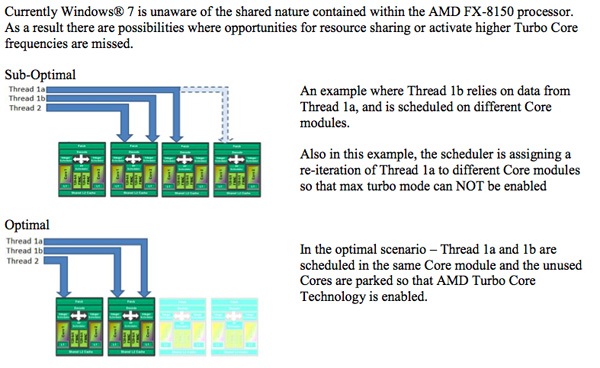Microsoft Releases Hotfix to Improve Bulldozer Performance UPDATE: Pulled
by Kristian Vättö on December 16, 2011 9:29 AM ESTThe launch of Bulldozer in October wasn't exactly a success for AMD. In our review, Anand ended up recommending the Intel i5-2500K over AMD FX-8150. One of the reasons behind the poor performance of Bulldozer is its unique design: each Bulldozer module consists of two integer and one floating point core. Todays operating systems don't know how to optimally schedule threads for this design and as a result, the full potential of Bulldozer has not been achieved. Microsoft has released a hotfix for Windows 7 and Server 2008 R2 that should increase the performance of Bulldozer.
Let's look at the problem to see what happened and how the hotfix helps address it. Before the update, Windows didn't know how to ideally schedule threads on Bulldozer. Essentially, it didn't know when it was good to place threads on single module versus multiple modules.

The picture above explains this pretty well. Before the update, Windows more or less randomly placed the threads which meant many modules were unnecessarily active at the same time. This capped the maximum Turbo speeds because those can only be achieved when some of the modules are inactive (power gated).
VR-Zone is claiming that Windows sees one Bulldozer module as a single multi-threaded core, similar to an Intel Hyper-Threading core. Basically, your 8-core FX-8150 is seen as a quad-core, 8-thread CPU—just like Intel's i7-2600K for instance. This goes against AMD's design and marketing because Bulldozer is closer to an 8-core CPU.
We have not yet tested Bulldozer with the hotfix, but don't expect miracles as Microsoft is suggesting a 2-7% increase. Better scheduling for the Bulldozer CPUs will improve performance a bit, but not enough to close the gap in many scenarios. Windows 8 already has the new thread scheduler, and according to AMD's own and third party tests the performance increase is up to around 10%, but Bulldozer needs a lot more than 10% to surpass Sandy Bridge.
Update: VR-Zone reports (and we can confirm) that the download link for the hotfix is no longer functional. There were apparently unexpected performance drops in some cases after applying the hotfix and Microsoft is investigating the issues. Modifying the scheduler in Windows is not something to be done lightly, as it changes a core element of the OS, so more testing and validation for such updates is always a good idea.
Update 2: Apparently there is a second part to the hotfix that was not pushed live, and this hotfix was pushed live prematurely.
Source: Microsoft










75 Comments
View All Comments
MadMan007 - Friday, December 16, 2011 - link
Might as well wait until Haswell unless you really want lower power consumption or find yourself CPU-bound a lot.stimudent - Saturday, December 17, 2011 - link
I'm waiting for Collapsed Bridge.niva - Tuesday, December 20, 2011 - link
Yeah wth, 10% is a HUGE deal. It might actually make the BD a better performer than the Phenom IIs now.Kryten67 - Friday, January 27, 2012 - link
I wrote a benchmarking tool in 1999 which stress-tests the CPU's ability to context switch and perform small/large memory copy operations.I run the test to pin everything on one core of the processor.
Doing so reveals that a new Opteron 6204 runs at about HALF the speed of an i7 920 or even a E3-1230.
I've opened up support tickets with AMD and SuperMicro to see if I can get to the bottom of this issue, but it's a very concerning performance issue.
kishorshack - Friday, December 16, 2011 - link
My basic question question here is why microsoft took months to address this issue, anyways wasnt anything that could have been done from AMD's side to tackle this issue?????N4g4rok - Friday, December 16, 2011 - link
Maybe a driver, but that still would have just been a topical fix. The OS's thread scheduler is where the issue comes from. A new set of drivers wouldn't be able to dictate the way the OS handles parrallel processing, and it would ahve just consumed mroe unnecessary system memory.crimson117 - Friday, December 16, 2011 - link
AMD could have identified this issue during testing and worked with Microsoft to release the patch before Bulldozer was released.MonkeyPaw - Friday, December 16, 2011 - link
For all we know, they did and it has taken this long to straighten it out. I imagine it's not a small change.I wonder what would happen if you applied this fix to an Intel SMT system? :p
TormDK - Saturday, December 17, 2011 - link
Microsoft has much bigger conserns than a 2-5% hotfix for a certain kind of CPU when we are talking about changing the Scheduler in Windows Core.You do not do this without making certain overall Windows performance is not effected, Microsoft does not Hotfix it's core OS parts that often. It typically takes four to six months from an issue is identified, till a hotfix is provided depending on how business critical it is (Hint, AMD's issue isn't critical in that sense)
knedle - Friday, December 16, 2011 - link
Microsoft took month to eliminate Pentium HT issue, so I think it's just the way all bi corporation are - big, slow and ugly ;)